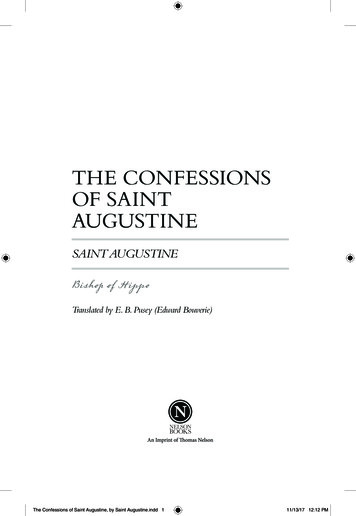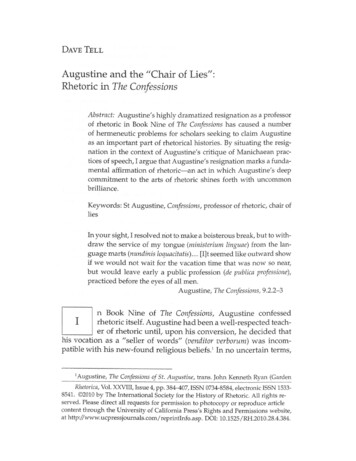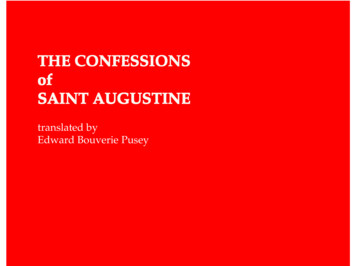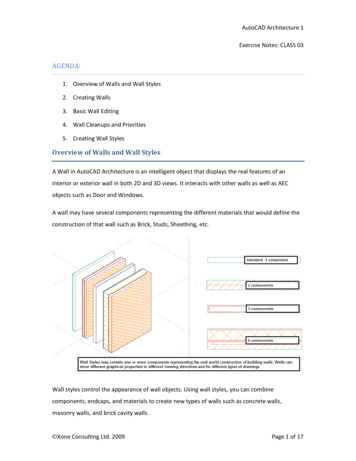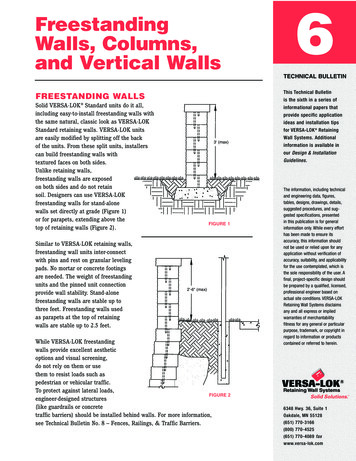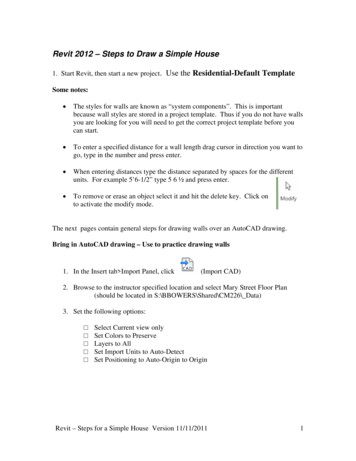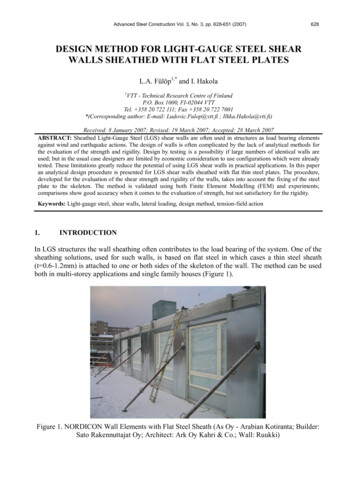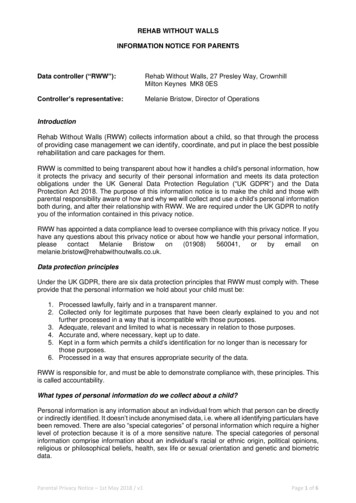
Transcription
The Walls of the Confessions:Neo-Romanesque Architecture, Nationalism, and Religious Identity in the KaiserreichbyAnnah KriegB.A., Lawrence University, 2001M.A., University of Pittsburgh, 2004Submitted to the Graduate Faculty ofThe School of Art and Sciences in partial fulfillmentof the requirements for the degree ofDoctor of PhilosophyUniversity of Pittsburgh2010
UNIVERSITY OF PITTSBURGHSCHOOL OF ARTS AND SCIENCESThis dissertation was presentedbyAnnah KriegIt was defended onApril 2, 2010and approved byChristopher Drew Armstrong, Director of Architectural Studies and Assistant Professor,History of Art and ArchitecturePaul Jaskot, Professor, Art History , DePaul UniversityKirk Savage, Professor and Chair, History of Art and ArchitectureTerry Smith, Andrew W. Mellon Professor of Contemporary Art History and Theory, Historyof Art and ArchitectureDissertation Advisor: Barbara McCloskey, Associate Professor, History of Art andArchitectureii
The Walls of the Confessions:Neo-Romanesque Architecture, Nationalism, and Religious Identity in the KaiserreichAnnah Krieg, PhDUniversity of Pittsburgh, rchitectureasastylisticmanifestation of the homogenizing and nationalizing impulse of the Kaiserreich. Images offortress-like office buildings and public halls with imposing facades of rusticated stone dominateour view of neo-Romanesque architecture from the Kaiserreich (1871-1918). The three religiousbuildings at the core of this study - Edwin Oppler’s New Synagogue in Breslau (1866-1872),Christoph Hehl’s Catholic Rosary Church in Berlin-Steglitz (1899-1900), and Friedrich Adler’sProtestant Church of the Redeemer in Jerusalem (1893-1898) – offer compelling counterexamples of the ways in which religious groups, especially those that were local minorities,adapted the dominant neo-Romanesque style to their own particular quest towards distinctiveassimilation in an increasingly complex, national, modern society. This synagogue and thesechurches belong to an important sub-section of German neo-Romanesque architecture that callsinto question our standard narrative of the Wilhelmine neo-Romanesque style as a universalizingand secularizing aesthetic. This synagogue, Catholic parish church, and Protestant church forgeda new alliance of religion and politics in the service of two often conflicting masters: thereligious community and the nation-state. By reinventing neo-Romanesque forms for a modern,yet still religious context, Edwin Oppler, Christoph Hehl, and Friedrich Adler provide the crucialiii
link necessary to incorporate medievalist architecture into the larger narrative of Germany’smodernization.While these sacred structures are prime exemplars of many social and architecturalthemes, my aim is to present them neither as isolated case studies nor as highlights in acomprehensive survey of Wilhelmine religious architecture. I treat these three sacred structuresas central case studies while considering their architecture, decorative programs, and mediatedpresentation in photography and print publications. The core themes of this work – the strugglebetween religion and national secular society, a longing for an imagine past as inspiration tocreate new styles for a new configuration of community – are not only the essential componentsof our definition of modernity but also what continues to frame our experiences today.Ultimately, these buildings serve as models to understand the challenges of diversity andmulticultural society that continue to define our world.iv
TABLE OF CONTENTSACKNOWLEDGEMENTS . IX1.0BETWEEN THE SECULAR AND THE SACRED: THE NEO-ROMANESQUEIN HISTORICAL CONTEXT . 11.1BUILDING AND RELIGIOUS IDENTITY IN BRESLAU, BERLIN, ANDJERUSALEM . 71.2STYLE AND NATIONALISM IN NINETEENTH-CENTURY GERMANY131.3APPROACHES TO MEDIEVALISM IN THE HISTORIOGRAPHY OFMODERN ARCHITECTURE . 242.0“THE GERMAN JEW IN THE GERMAN STATE MUST ALSO BUILD INTHE GERMAN STYLE”:EDWIN OPPLER CONCEPTUALIZES A GERMAN-JEWISH NATIONAL STYLE IN THE NEW SYNAGOGUE OF BRESLAU. 352.1THE HISTORY OF CIVIL RIGHTS AND RELIGIOUS REFORM IN THEBRESLAU JEWISH COMMUNITY . 422.2EDWIN OPPLER, ABRAHAM GEIGER, AND THE BEGINNINGS OFTHE REFORM MOVEMENT IN BRESLAU . 462.3THE ARCHITECTURAL PRECEDENTS FOR THE NEW SYNAGOGUE:RUNDBOGENSTIL AND THE HANNOVER SCHOOL. 49v
2.4STYLE WARS: INVENTING A GERMAN JEWISH ARCHITECTURE 562.5THE BRESLAU JEWISH COMMUNITY IN THE 1860S AND THECOMMISSION OF THE NEW SYNAGOGUE . 632.6A JEWISH-GERMAN NEO-ROMANESQUE COMES TO FRUITION:THE CONSTRUCTION AND DEDICATION OF THE NEW SYNAGOGUE INBRESLAU . EMPORARY CHRISTIAN ARCHITECTURE IN BRESLAU . 782.8THE LEGACY OF OPPLER’S NEW SYNAGOGUE AND LATER NEO-ROMANEQUE SYNAGOGUES . 833.0“NOW I PROPHESIZE, LEHNIN, YOUR FUTURE DESTINY”: CHRISTOPHHEHL AND THE REVIVAL OF THE ROMANESQUE ROOTS OF BERLINCATHOLICISM IN THE ROSARY CHURCH . 903.1THE CULTURAL BATTLE: THE CATHOLIC CHURCH IN GERMANYIN THE MODERN ERA. 943.2AN OUTPOST IN BRANDENBURG:THE BEGINNINGS OF ACATHOLIC PARISH IN STEGLITZ AND THE FIRST PARISH PRIEST, JOSEFDEITMER . 1023.3CHRISTOPH HEHL AND THE CENTRAL PLAN CHURCH . 1063.4THE “BEGGAR PRIEST” ATTEMPTS TO FINANCE THE ROSARYCHURCH . 1133.5THE INFLUENCE OF THE CISTERCIAN MONASTERIES OF THEMARK BRANDENBURG . 117vi
3.6SPATIAL ORGANIZATION AS THE BEARER OF MEANING:THECENTRAL PLAN AND THE WESTWORK . 1233.7THE ROSARY CHURCH AS GESAMTKUNSTWERK:INTERIORDECORATION. NISM . 1314.0“AN IMAGE, SO COLORFUL, SO RADIANT AND IMPRESSIVE, SINCEEVER THERE HAS BEEN AN EVANGELICAL CHURCH”:FRIEDRICH ADLERINTRODUCES THE PROTESTANT NEO-ROMANESQUE TO THE INTERNATIONALSTAGE IN THE CHURCH OF THE REDEEMER IN JERUSALEM . 1344.1PROTESTANTISM IN NINETEENTH-CENTURY GERMANY . 1434.2THE ANGLICAN-PRUSSIAN BISHOPRIC AND EARLY EFFORTS TOESTABLISH A GERMAN PROTESTANT CHURCH IN JERUSALEM . TION OF THE CASTLE CHURCH IN WITTENBERG. 1564.4PLAIN AND SEVERE: THE DESIGN AND CONSTRUCTION OF THECHURCH OF THE REDEEMER . 1594.5A GERMAN CRUSADER IN JERUSALEM:KAISER WILHELM IITOURS PALESTINE AND ATTENDS THE DEDICATION OF THE CHURCH OFTHE REDEEMER. 1674.6INTER-GERMAN DIPLOMACY: THE KAISER, GERMAN JEWS ANDCATHOLICS IN THE HOLY LAND . 175vii
4.7THE CONTINUED PRESENCE AND LEGACY OF KAISER WILHELMII IN PALESTINE . 1785.0MEDIEVALISM, RELIGION, AND THE STATE: IMPLICATIONS BEYONDTHE KAISERREICH. 181BIBLIOGRAPHY . 191viii
ACKNOWLEDGEMENTSI would like to think my interest in neo-Romanesque architecture began with my firstcollege course, Freshman Studies, which took place in a looming, round-arch neo-Romanesqueacademic building on the campus of Lawrence University. My teacher for that course, MichaelOrr, and his fellow art historian, Carol Lawton, instilled in me a fascination for the visualcultures of the past during my time as a student at Lawrence. They have continued to supportmy professional development and gave me a wonderful opportunity to return to Lawrence toteach while finishing my dissertation.I have also been fortunate to have mentors in graduate school who have continued tochallenge and encourage me. My advisor, Barbara McCloskey, has been an unfailing supportthroughout my graduate school career. She first introduced me to Paul Jaskot, whose enthusiasmsustained me when my own had withered. My committee members – Kirk Savage, Terry Smith,and Drew Armstrong – have also provided guidance, assistance, and support during my time atthe University of Pittsburgh.A Fulbright Fellowship to Berlin and Andrew R. Mellon Pre-Dissertation and Art and SciencesGraduate Fellowships at the University of Pittsburgh provided me with the luxury of focusing onmy research full-time. Various archives and libraries in Germany and Poland assisted me in myresearch and helped me navigate their collections, including the National Library, Freeix
University Library, Evangelical Central Archives, Rosary Church Archives, Jewish Museum,and Centrum Judaicum in Berlin; the Jewish Historical Institute in Warsaw; and the City Archivein Hannover.My project benefitted greatly from my participation at the ZEIT-Foundation “HistoryTakes Place” seminar and conference in Wrocław in 2005 and at the Warburg Colloquium inHamburg the following year. I presented portions of my developing work at the annual meetingof the German Studies Association in 2007 and 2008, the Graduate Student Symposium inNineteenth-Century Art in 2008, and the annual meeting of Society for Architectural Historiansin 2009 and was grateful for the fruitful exchange and discussions at those conferences.While a dissertation is solitary work, I had a host of family members and friends whoknew when to encourage me and ask questions about my work and the times to leave theprofessional questions aside and provide much-needed outlets.My parents have alwaysunconditionally supported me from afar. Friends Robyn Cutright, Itohan Osayimwese, JuliaFinch, Sylvia Rhor, Bal Srinivasan, Debbie Pagels, Margaret Schroeder, Ellen Saksen, PeterCramer, Markus Mittasch, Elke-Sophia Mazur, and Alexandra Gruber have acted as moralsupport, advisors in topics from theology to graduate school survival, running partners, and bedand breakfast proprietors for me over the past four years.It is my husband who has experienced all of the triumphs and frustrations of adissertation more than anyone else and I dedicate this work to him. With a kind word and aperpetual smile, he kept me well-fed and well-grounded. Max also nursed me through twofractures and one surgery during the final grueling months. To a large extent, our marriage hasbeen defined by this work up to this point. The next step begins now.x
1.0 BETWEEN THE SECULAR AND THE SACRED: THE NEO-ROMANESQUE INHISTORICAL CONTEXTIn 1907, Protestant theologian Adolf Harnack saw a problem in German society. He declared,In numerous and important questions of life and of the common weal, our nationis at the outset divided into two camps, and this state of affairs, starting from the center,works its way into the periphery of our existence, deep into the smallest and mosteveryday aspects of our lives.Everywhere one confronts confessional prejudice;everywhere one encounters the fences, indeed the walls of the confessions. 1It is tempting to understand the “two camps” to which Harnack refers as those ofreligious and secular interests in German society. Indeed, the widening chasm between religionand secularism is one of the key struggles we perceive today as paramount in the history of themodernizing European nation-state.Noting the encroachment of a division into all aspects oflife, Harnack’s tone is defensive, as if he is attempting to uphold his Protestant faith against arising tide of secularism that threatened to limit his realm of influence.1However, our“In zahlreichen und tiefen Fragen des Lebens und der öffentlichen Wohlfahrt ist unser Volk von vornherein inzwei Lager gespalten, und dieser Zustand wirkt aus dem Mittelpunkt überall in die Peripherie unsres Daseins bishinab in die Sphäre des Kleinsten und Alltäglichen. Ueberall begegnet man den konfessionellen Vorurteil; überallstößt man auf die Zäune, ja die Mauern der Konfessionen.” Adolf Harnack, Protestantismus und Katholizismus inDeutschland (Berlin: Verlag von Georg Stilke, 1907), 4-5.1
contemporary perspective easily erases the specific dimension of Harnack’s quote, preventing usfrom fully understanding the implications of his statement. His words were not arrayed againstsecularists, and much less against Jews, but rather against Catholics and their growing presencein German public life in the late nineteenth and early twentieth centuries. It is, in fact, theChristian world which forms the reference of his allusion. This divide between Protestants andCatholics historically defined Germany in a more profound way than debates between religiousGermans and the small fraction of their peers who were not affiliated with any religion. 2 Jews,moreover, were rapidly gaining social presence during the Kaiserreich, a group Harnack does noteven include in his “two camps.” For them, the “walls of the confessions” had long been a literalphysical barrier, namely, the ghettoes erected in many German cities beginning with Breslau in1267. Harnack’s evocative statement offers us a glimpse into these religious divisions andcontentions in Wilhelmine Germany.It reminds us that despite massive social upheavalsresulting from urbanization and industrialization, religious identity remained a powerful andincreasingly complex force in modern imperial Germany.By the latter half of the nineteenth century a new and more material concept ofconfessional walls had emerged as Protestants, Catholics, and Jews alike now competed to staketheir architectural claim in the urban landscape. Harnack spoke more about the metaphoricalwalls of discrimination and religious intolerance than actual ecclesiastic architecture. Yet by thetime of his writing in 1907, he had witnessed a huge German religious building boom not only inhis Berlin home, but all over the world, from German missionary construction in Africa andwestern Asia to state-sponsored Protestant churches in Windhoeck, Alexandria, and Jerusalem.2For the purpose of this study, I translate the German term “Konfession” as confession, religion, or religious group,depending on the context. This is a broader interpretation of the term, as it is typically associated with differentgroups within Protestantism.2
In Berlin alone, the founding of the Evangelical Church Aid Association in 1888 (after 1900, theEvangelical Church Building Association) led to the construction of over 65 Protestant churchesin and around Berlin between 1889 and 1904. 3 Between 1780 and 1933, approximately 2,100synagogues or prayer rooms were built in Germany. 4 Even the Catholics, crippled by therepressive legislation of Chancellor Bismarck’s Kulturkampf in the 1870s, rallied via clubs andassociations to build new churches for their rapidly growing parishes in Berlin and other Prussianmetropoles. A theologian of Harnack’s stature could not have overlooked the theological andliturgical, as well as the social, economic and political effects on German society as a whole thatthe building of these churches and synagogues represented.These walls of confession were laid and mortared in a period of immense upheaval thatgave birth to the first German nation-state.New political parties and social organizationscompeted for the membership of the religiously devout. Meanwhile, aggressive industrializationforcibly reordered the lives of many Germans. While historians tend to focus on the secularaspects of these processes of modernization, they do so at the cost of neglecting the religiousmobilization these forces spawned. One exception to this tendency is historian Olaf Blaschke,whose research has explored the nineteenth century as a second confessional age. 5 Blaschke isprecise in his choice of period label, drawing a connection to the first confessional age of theReformation and subsequent Counter-Reformation in the sixteenth and seventeenth centuries.The relative de-confessionalization of the second half of the eighteenth century and3Paul Seidel, Der Kaiser und die Kunst (Berlin: Schall, 1907), 74-6.Harold Hammer-Schenk, Synagogen in Deutschland: Geschichte einer Baugattung im 19. und 20. Jahrhundert(1780-1933) (Hamburg: Hans Christians Verlag, 1981), 14.5Olaf Blaschke, “Das 19. Jahrhundert: Ein Zweites Konfessionelles Zeitalter?,” Geschichte und Gesellschaft 26(2000): 38-75.43
Enlightenment secularization separates in his account these two periods of heightened religiousactivity.Blaschke’s work stands apart from mainstream histories of nineteenth-century Europethat continue to describe religious practice of the era as a vestige of an old order on the wane inthe “bourgeois age,” the “age of liberalism,” or the “age of secularization.” 6 These modelsprivilege bourgeois life as the quintessential modern experience, although only 5-6% of thepopulation in 1900 belonged to that class.Blaschke turns this secular, economic-drivenparadigm around. The overwhelming majority of Germans (99.97% of the population accordingto his findings) labeled themselves as part of a confession or an officially recognized religiousgroup in 1900. As a way to understand the age from the standpoint of those who lived it,Blaschke upholds religious identity as the defining element of Wilhelmine society. With hiswork and the investigations of other more recent scholars, the complex religious situation of theGerman Kaiserreich has become less history’s afterthought. The formation of secular, nationalgovernments has also become less our navigational star in our attempts to unravel the complexityof Germany’s modernization. As the tumultuous international events of the first decade of thetwenty-first century have shown us, the relationship between religion, secularism, and the state isongoing and it also remains neither peaceful nor stable.6See Franz Schnabel, Deutsche Geschichte im neunzehnten Jahrhundert (1929-37; reprint, Munich: DeutscherTaschenbuch Verlag, 1987); Wolfram Siemann, “Politik, Staat und Verfassung Deutschlands im Zeitalter desLiberalismus” Neue politische Literatur 40 (1995): 365-380; Wolfgang J. Mommsen Bürgerliche Kultur undkünsterlische Avantgarde. Kultur und Politik im deutschen Kaiserreich 1870-1918 (Frankfurt: Ullstein, 1994);Thomas Nipperdey, Deutsche Geschichte 1800-1866. Bürgerwelt und starker Staat (Munich: C.H. Beck, 1983).Other scholars, in addition to Blaschke, have begun to recast the nineteenth century as an era defined to a largeextent by religious conflict and restructuring. Just a few prominent examples are: Margaret Lavinia Anderson, “TheLimits of Secularization: On the Problem of the Catholic Revival in 19th Century Germany,” Historical Journal 38,no. 3 (1995): 647-670; Thomas Nipperdey, Religion im Umbruch: Deutschland 1870-1918 (Munich: C.H.Beck,1988); Helmut Walser Smith, ed., Protestants, Catholics and Jews in Germany 1800-1914 (Oxford and New York:Berg, 2001).4
Indeed, religion has been and continues to be an inherent part of the modern experienceboth in and beyond Germany. We are compelled to view religion not as a static retrogradeidentity but rather as a part of a modern self-consciousness. Benedict Anderson originallydeveloped the notion of a modern self-consciousness in his groundbreaking study of the rootsand evolution of nationalism. 7 However, he does not include the religious experience as an axisof identity that engages with and influences the ideology of nationalism. I introduce this keyreligious facet to Anderson’s notion of a modern self-consciousness to enable a dynamicconnection between different axes of modern identity – religious, national, regional, and socioeconomic – as a relationship of ebb and flow that pulsed through the very fabric of everyreligious community in the Kaiserreich.The paths to modernization of the three major religions in the Kaiserreich were oftendisjointed and fragmentary.Different confessional allegiances formed to face differentchallenges and legislation was slow and incomplete in rising to meet social changes. 8 Keytransformative moments in nineteenth-century Germany – French occupation of Germanterritories beginning in 1795 on the west bank of the Rhine, the dissolution of the Holy RomanEmpire in 1806, the 1848 revolution and the resulting Frankfurt Assembly – achieved little interms of Jewish emancipation. Their full citizenship came in the constitution of the NorthGerman Confederation in 1866, later adopted by the Second Empire in 1871. For Catholics,their relationship with the Protestant Church was more complex, as they held considerable powerin the kingdom of Bavaria and other southern German lands. However, in Prussia they shared7Benedict Anderson, Imagined Communities: Reflections on the Origin and Spread of Nationalism, rev. ed.(London and New York: Verso, 1991).8This section serves as a general overview of the state of the three major religions in Wilhelmine Germany. Eachchapter contains a more detailed history of the individual religious groups, their emancipation, and their religiouspractice in the modern era.5
similar hindrances as the Jews, facing severe discrimination in the university, the military and thediplomatic and bureaucratic corps. With the introduction of Bismarck’s oppressive Kulturkampfimmediately after the declaration of the empire in 1871, Catholics endured further religious,social and economic oppression. They formed the Center Party in 1871 to mobilize politicallyagainst Bismarck, which proved to be an effective front against the Iron Chancellor and hissupporters. In the 1870s, Jews also formed different clubs, or Vereine, devoted to differentpolitical interests, sports and gymnastics (Turnvereine), and social causes. In this period of thepoliticization of religion, Zionism became a viable response to rising anti-Semitism in Germany.Protestants answered with social and cultural associations of their own – most importantly, thePan-German League (Alldeutscher Verband, founded 1886) and the Protestant League to DefendGerman-Protestant Interests (Evangelischer Bund zur Wahrung der deutsch-protestantischenInteressen, also founded 1886).As Germany’s state religion, Protestantism did not face the same political and economicbarriers as Catholicism and Judaism, but it did undergo, as did the other confessions, penetratingreform in liturgy and practice. As the religions lost their all-encompassing grip on their flocks inthe midst of social upheaval brought on by urbanization and industrialization, leaders needed todevise ways in which their confessions could modernize alongside civil society. For the Jewsthis phenomenon led to the creation of an entirely separate sub-strain of Judaism – the ReformMovement. Started in Breslau by a rabbi who sought religious expression that better alignedwith the modern world beyond the synagogue doors, Reform Judaism embraced prayers andsermons in the vernacular, instrumental music, and a more organized worship service thatemphasized communal values. Similarly, the liturgical movement in the Catholic and Protestantchurches emphasized sermons and a congregation-centered service which strove to keep6
members connected in an era of increasing uprootedness. For Catholic authorities this alsomeant greater toleration for popular forms of piety, including pilgrimages and local saint cults.9In the Protestant Church religious organizations like the Order of St. John or the TemplarSociety, as well as social clubs and associations, sought to promote a heightened sense ofcommunity through wider political and social engagement. Protestants, Catholics, and Jewsalike, moreover, sought visible expression of their presence in Germany’s emergent nation-state.1.1BUILDING AND RELIGIOUS IDENTITY IN BRESLAU, BERLIN, ANDJERUSALEMGothic pointed arches were slowly falling out of favor and some Romanesque churches andfortresses were already crumbling during the first confessional era of the sixteenth century. Therenewed religious fervor of the nineteenth century, however, drew on this earlier medievalarchitecture as source material for its visual culture. For the purpose of this study I definemedievalism as the modern appropriation and manipulation of artistic and architectural forms orthe reinstigation of particular institutions (the notion of the cathedral building guild, for example)from the fourth to the fifteenth centuries.This modern medievalism, which found manysupporters, was neither a straightforward imitation of past styles nor a purely preservationisteffort. Prussian King Friedrich Wilhelm IV (ruled 1840-1861), Bavarian King Ludwig I (ruled1825-1848), writers like Goethe, artists like the Nazarenes, and architects like Karl FriedrichSchinkel all pondered a place for medieval religious visual forms in the modern era. And by the9There are some late medieval precedents for modernizing developments in the church such as preaching in thevernacular. See Eamon Duffy, The Stripping of the Altars: Traditional Religion in England 1400-1580 (NewHaven: Yale University Press, 1992).7
mid-nineteenth century, these visual forms -- as applied specifically to architecture -- fed into therevival of the Romanesque.Scholars have long recognized neo-Romanesque architecture as a stylistic manifestationof the homogenizing and secularizing impulse of the Kaiserreich. Images of fortress-like officebuildings and public halls with imposing facades of rusticated stone came to dominate manycities and towns throughout Germany during this period. By 1900, the neo-Romanesque indeedhad become something of a “state” style. Against this backdrop, however, architects and theirreligious patrons turned towards the neo-Romanesque as a style which could not only stake theirplace in the regime, but also encapsulate the different axes of their multi-layered, secularizing aswell as sacred, identities.I present three buildings at the core of this study - Edwin Oppler’s New Synagogue inBreslau (1866-1872), Christoph Hehl’s Catholic Rosary Basilica in Berlin-Steglitz (1899-1900),and Friedrich Adler’s Protestant Church of the Redeemer in Jerusalem (1893-1898).Thissynagogue and these two churches offer compelling examples of the adaptation of the dominantneo-Romanesque style to particular quests as these groups situated themselves in an increasinglycomplex, national, modern society. Each is in an urban multicultural setting in which thereligion under consideration is a social minority: Jews in Breslau, Catholics in Berlin, andGerman Protestants in Jerusalem. This situation gives the buildings added cultural and socialsignificance as they quite literally helped to build these religious communities and give themphysical expression in their environment. While Oppler, Hehl, and Adler each belonged to therespective confession for which they built the New Synagogue, Rosary Church and Church ofthe Redeemer, they also completed a wide range of work during their careers and had important8
contacts in the international community of medievalist architects and theorists. This widercontext is imperative when considering the architects’ particular works at the center of my study.The New Synagogue, Rosary Church and Church of the Redeemer are not part of themainstream architectural canon. They belong, however, to an important sub-section of Germanneo-Romanesque architecture that calls into question our standard narrative of Wilhelmine neoRomanesque building as a universalizing and secularizing aesthetic. This synagogue, Catholicparish church, and Protestant church forged a new alliance of religion and politics in the serviceof two often conflicting masters: the religious community and the nation-state. By reinventingneo-Romanesque forms for a modern, yet still religious context, Oppler, Hehl, and Adler providea crucial link between medievalist architecture and the larger narrative of Germany’smodernization.The New Synagogue in Breslau tells the story of a rabbi and congregation at the forefrontof Jewish modernization. They collaborated with Oppler, a well-known, cosmopolitan architect,to create a striking balance between their German and Jewish Reform identities by means of theiconic forms of the German Transitional Style, the period of hybrid forms between theRomanesque and Gothic eras in Germany. The late Romanesque/early Gothic cathedral ofWorms, specifically its
assimilation in an increasingly complex, national, modern society. This synagogue and these churches belong to an important subsection of German neo- -Romanesque architecture that calls into question our standard narrative of the Wilhelmine neo-Romanesque style as a universalizing and secularizing aesthetic.


